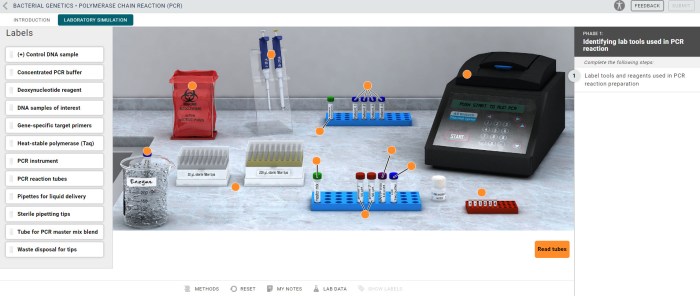Bacterial identification virtual lab answers provide a gateway into the fascinating realm of microbiology, empowering learners to unravel the complexities of bacterial identification with unparalleled accuracy and efficiency. Through engaging virtual simulations, students can immerse themselves in a hands-on learning experience, mastering the techniques and principles that underpin this critical field.
Virtual labs offer a transformative approach to bacterial identification, bridging the gap between theoretical knowledge and practical application. By eliminating the constraints of traditional laboratory settings, they empower learners to conduct a comprehensive range of tests, analyze results, and interpret findings, all within a safe and accessible digital environment.
Bacterial Identification Virtual Lab Overview
The Bacterial Identification Virtual Lab provides an interactive platform for students and researchers to learn about the principles and techniques used to identify bacteria. The virtual lab simulates a real-world laboratory environment, allowing users to perform a series of tests on unknown bacterial samples to determine their identity.
Bacterial identification is essential in healthcare and research, as it helps clinicians diagnose and treat infections, and researchers study the diversity and evolution of bacteria. The virtual lab provides a safe and accessible way to gain hands-on experience with bacterial identification techniques, without the need for expensive equipment or hazardous materials.
Methods and Procedures
Experimental Setup
The virtual lab provides a virtual workbench with all the necessary equipment and materials for bacterial identification, including a microscope, staining reagents, and biochemical test kits.
Step-by-Step Procedures
- Prepare a bacterial smear from the unknown sample.
- Perform Gram staining to differentiate between Gram-positive and Gram-negative bacteria.
- Conduct biochemical tests, such as catalase test, oxidase test, and indole test, to determine the metabolic characteristics of the bacteria.
- Interpret the results of the tests using a dichotomous key or a database to identify the unknown bacterial sample.
Principles Behind the Tests
Each bacterial identification test is based on specific principles:
- Gram staining differentiates bacteria based on the structure of their cell walls.
- Biochemical tests determine the presence or absence of specific enzymes or metabolites, which are characteristic of different bacterial species.
Data Analysis and Interpretation: Bacterial Identification Virtual Lab Answers
Organizing the Results
The results of the bacterial identification tests are organized in a table format, with each row representing a different test and each column representing a different bacterial sample.
Interpreting the Results
The results are interpreted using a dichotomous key or a database. The dichotomous key provides a series of questions that guide the user through a logical decision-making process to identify the unknown bacterial sample. The database contains a list of bacterial species with their corresponding test results, which allows the user to compare the results of the unknown sample to those in the database to determine its identity.
Limitations and Errors, Bacterial identification virtual lab answers
The virtual lab results may not be as accurate as those obtained in a real-world laboratory, due to limitations in the simulation software. Additionally, errors can occur during the performance of the tests, such as incorrect staining or contamination of the sample.
Applications and Implications

Practical Applications
Bacterial identification is essential in clinical settings for diagnosing and treating infections. It helps clinicians determine the appropriate antibiotics to use and to track the spread of infectious diseases. In research, bacterial identification is used to study the diversity and evolution of bacteria, as well as to develop new diagnostic and therapeutic tools.
Virtual Labs
Virtual labs provide several advantages over traditional laboratory methods. They are more accessible, as they can be accessed from anywhere with an internet connection. They are also more cost-effective, as they do not require expensive equipment or materials. Additionally, virtual labs can provide a more interactive and engaging learning experience.
Future Prospects
The future of bacterial identification technologies includes the development of new molecular techniques, such as whole-genome sequencing, which can provide more accurate and comprehensive identification of bacteria. Additionally, the integration of artificial intelligence into bacterial identification systems is expected to improve the efficiency and accuracy of the identification process.
Question Bank
What are the advantages of using virtual labs for bacterial identification?
Virtual labs offer numerous advantages, including increased accessibility, cost-effectiveness, safety, and the ability to repeat experiments multiple times without consuming resources.
How do virtual labs enhance the learning experience for bacterial identification?
Virtual labs provide an immersive and interactive learning environment, allowing students to visualize complex concepts, manipulate variables, and receive immediate feedback on their results.
What are the limitations of virtual labs for bacterial identification?
While virtual labs offer many benefits, they cannot fully replicate the hands-on experience of a traditional laboratory setting. Additionally, they may require specialized software and hardware, which can limit accessibility for some learners.